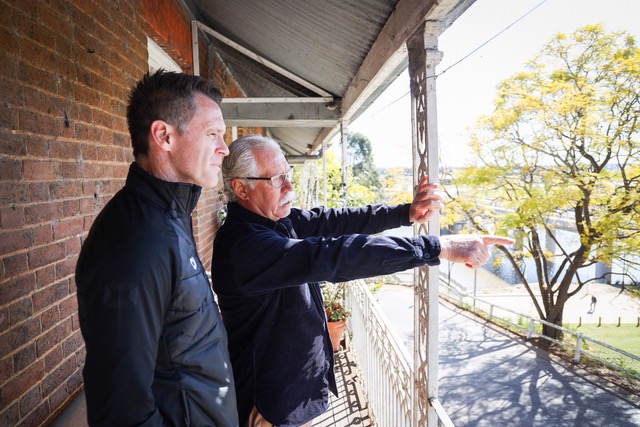From the Editor Here we are...


From the Editor Here we are...

The NSW Government is rethinking its water...

Residents and ratepayers have slammed the Hawkesbury City...

Calling all beekeepers – keep an eye out for cane toads in the Hawkesbury because they like to eat your bees and they are now in our region.
Hot on the heels of our story on cane toads discovered in the Hawkesbury at Windsor Downs, the Peri-urban Environmental Biosecurity Network (PEBN) have been in touch to tell us about this year’s Toad at the Hive blitz which runs all of this month.
Have you heard a cane toad calling? Listen here
Cane toads love to eat bees, so beekeepers can assist by looking out for them around backyard hives.
They will also eat cat and dog food which may have been left outside.
Both backyard beekeepers and residents are asked to keep a look out for cane toads and report their findings.
In the warmer months when cane toads are more active and the nights are warm, bees cluster at the front of hives for ventilation. Trouble is, cane toads know this and will sit at the entrances to hives and feast on bees.
The PEBN wants as many people to register as possible for Toad at the Hive so you can report any cane toad sitings, and you don’t have to have a bee hive to take part, you can look in your own backyard, open areas, or local freshwater waterways too.
How to participate
Register at https://forms.office.com/r/cBFQ1tzgMJ
Download the free FeralScan app and select Toad Scan or report online at dpi.nsw.gov.au/biosecurity/sighting.
Observe your hives around 9.30pm or later as this is when toads search for food. Use a torch (a red beam is best as bees may fly at white light). Wear your protective gear if you are more comfortable.
Report it! If you see a toad, it is important NOT to kill it as it may be a native toad or frog. Take a photo and use the FeralScan app or NSW DPI online form to report your sighting.
The PEBN also want to know if you don’t find anything. Any time you go out looking and there are no toads, let them know by leaving a comment on their Facebook page, including the date you looked, postcode, and add any description about the area you observed eg. backyard hives, backyard, recreational area, local waterway etc. You can also include any interesting observations while out looking).
How to report
Download the FeralScan app from the App Store or Google Play, select ToadScan and follow the prompts. Use this Guide on how to report using FeralScan.
If you prefer not to use an app you can report online at dpi.nsw.gov.au/biosecurity/sighting or call the Invasive Species Unit on 1800 680 244.
Tips and resources
Where to look: Hives are particularly vulnerable if located near fresh water or in yards where toads can shelter during the day. As night falls, they move out from their sheltered position to find food – this may also be the leftovers at the dog or cat bowl!
When to look: After dark is best as toads are more active at night. While checking hives be cautious with the torchlight as bees will sometimes fly at the light and may sting.
How many nights should you observe: The time you can commit is up to you, just a night here or there or several nights throughout the month if you wish.
Cane toad or native frog? Learn about the differences between native Australian frogs and cane toads at all life-stages to help you to make a positive ID when you are out toad-busting.
What does a cane toad look like? Download the Cane Toad Factsheet.
Have you heard a cane toad calling? Listen here
(Cane toad call courtesy of Nature Sound)
Watch this video on how to catch and report a suspect toad via the FeralScan app.
Why participate?
Cane toads can cause devastating impacts on our communities, native wildlife and ecosystems due to their ability to spread to new areas, use limited natural resources and to poison animals that try to eat them.
Cane toads are poisonous internally and externally and have no natural enemies and are dangerous to native animals and our domestic pets. By taking part in this community surveillance activity, you are helping to protect the environment from the impact of exotic pests.
Your participation will help in the management of toad populations to lessen the impacts they cause. The data collected from reporting will help in identifying the presence or absence of cane toads in certain areas. The more people out looking the better chance of finding them quickly before they can establish.
For a summary on how to participate in this blitz download the Toad at the Hive brochure.
Follow on Facebook for further updates
The ‘Toad at the Hive’ observation event is a collaboration between NSW DPI, Local Land Services ‘Every Bit Counts’ program and recreational beekeeper associations.
More information
The cane toad origin and management in NSW – NSW DPI website here
What is ToadScan and recording toad activity: here
Main picture – cane toads attacking bees at hive (Bufo marinus) in Queensland. Picture by Mark-Payne-Gill-naturepl.c
If you are already a Hawkesbury Post supporter, thank you! Our site is free, relying on our supporters to operate. Independent journalism is more important than ever, please consider contributing.
Don’t pay so you can read it. Pay so everybody can read it!